Creepy crawlies, quarks and counting
This week: How long can someone hold their breath and can you train for this? Who are fitter - footballers or rugby players? And what’s the most intelligent insect? We've assembled an expert panel to take on your science questions - University of York animal behaviour scientist Eleanor Drinkwater, exercise physiologist Dan Gordon from Anglia Ruskin University, Cambridge University physicist Fran Day, and Cambridge University mathematician and University Challenge icon Bobby Seagull!
In this episode

00:57 - Bee-keeping scientists!
Bee-keeping scientists!
Eleanor Drinkwater, Bobby Seagull, Fran Day, Dan Gordon
Chris Smith introduces the team answering your science questions this month. University of York animal behaviour scientist Eleanor Drinkwater, exercise physiologist Dan Gordon from Anglia Ruskin University, Cambridge University physicist Fran Day, and Cambridge University mathematician and University Challenge icon Bobby Seagull! First up, Chris asked Eleanor what she's been up to...
Eleanor - Well, I’m a very keen beekeeper and I made the very rookie mistake of not zipping up my own bee suit the other day, and I can tell you that that was bitterly regretted the next day. But this is very much a mark of pride among beekeepers.
Chris - You're not a proper paid up beekeeper until you've had at least one anaphylaxis.
Eleanor - Hopefully no one has anaphylaxis, that's a bad thing when it happens. But if you work with bees you do occasionally get stung.
Chris - Yeah. How's it going, the beekeeping?
Eleanor - Really, really good fun. We've had an absolutely lovely queen in one of our hives at the moment, the other one's a bit more grumpy so they're a bit more of a... it’s true... I’m getting laughed at here.
Chris - My brother keeps bees, Eleanor, and he says the same thing. He said that as the queens get older, and also certain colonies just have a particularly aggressive behaviour, it's something to do with the queen squirting out pheromones that keeps everyone calm, and as the queen ages she makes less of them.
Eleanor - Yes exactly, that's exactly it. And then the character of the queen or, you know, the chemicals that she produces, that has a really big impact on the behaviour of all the other bees in the colony. So yeah. So if you have a really nasty queen then you can swap out for a really friendly queen and suddenly the hive becomes a lot more friendly to work with. So it’s really incredible.
Chris - And also honey?
Eleanor - Oh, yes, some, not as much as we were hoping, unfortunately, but yes definitely enough to be getting on with.
Chris - Eleanor, thank you. So any questions you have about insects perhaps even bees, bee stings and beekeeping, ask Eleanor. Dan Gordon is also with us. Dan's an exercise physiologist, he is at Anglia Ruskin University. He's also a Paralympian and he's got a world record. And there was a lot of coverage in recent weeks about athletes using sports drinks and it not being terribly good for their dental health.
Dan - Yes. It came about I think about 10 days ago. Quite a large ranging study that was looking at elite athletes and they reported that the dental health in elite athletes was far, far worse than in the general population. Although the paper didn't fully attribute it to it, one of the main conclusions was that they thought it was down to the kind of sports drinks that are consumed, which are mostly these high carbohydrate loaded with sugar. Yeah.
Chris - Yeah. How's your dentistry doing? Are you alright?
Dan - Well, I think I got away with it actually. I think so, yeah.
Chris - Why do you think you got away with it?
Dan - I think partly genetics. My parents had incredibly good teeth. I mean, my father who died about three years ago, he never had a filling. So he died at the age of 78, he never had a filling, he had really good dental health.
Chris - All his teeth? Or even just the odd ones missing?
Dan - No, no teeth missing, he hadn’t lost any. No, it wasn't like you've got no teeth. So he got incredibly good teeth. And actually when you look in his family and you look at his brothers and you look at his... going back at my grandparents, they all got amazing teeth. So I think actually I got away with it in that in that sense.
Chris - What are they advocating that sports practitioners do then? Because you can't not have energy to do the events.
Dan - No. And I think in the end, what they're really getting at, I suppose, is that there's got to be greater scrutiny of the health of the teeth in athletes. I mean, you know, when I was competing, one of the things we had to do before we went to the Paralympics, every athlete had to have a full dental check. Which sounds like a crazy thing to do. You're going to Olympic Games, actually, you wouldn't think that teeth are that important. But actually the worst thing you can have at an Olympic Games is...
Chris - Toothache, to ruin your day...
Dan - Is toothache, yeah. And so one of the things that's really being advocated now is that part of the athlete support program, part of lifestyle management, should be to actually monitor the health of the teeth.
Chris - So you think warning people that there is this risk, do you think they'll probably take more care about washing their mouth out to get rid of the extra sugar etc?
Dan - Yeah, I think so. I think more use of things like mouth rinses, cleaning the teeth more regularly for example, as part of the training routine.
Chris - So any questions about exercise, exercise physiology, how the body works, sports and sports fitness, Dan’s your man. Now next to Dan, is Fran! See what I did there? Wonderful. Fran is a Cambridge University physicist. She is an astrophysicist, a cosmologist interested in how the universe at large works... but you’re also a stand up comedian as well, isn’t that right? How is that going? I'm not gonna do the horrible thing where you come in and say ‘Oh go on then tell us a joke’. I won't do that. But how is that going?
Fran - It's going pretty well. I'm writing a new show at the moment about the philosophy of science and what we're really doing when we're doing science. So that has been a bit of a step back from the day to day of my research.
Chris - Are you poking fun at it, or are you kind of making light of what life as a scientist and a researcher is like? Is that the thrust of the show?
Fran - Yes, I'm poking fun at it. But there's also I think a serious element of it. And I hope people will come away knowing a bit more about... you know, I've been told I'm participating in the scientific method, but I never really examined what that meant until now.
Chris - You're gonna find out. You were also saying to me just before we started about the story that came out earlier this year, the first picture of a black hole or rather the first impression of a black hole. And that's actually going to be made into a movie rather than just a bunch of static pictures, now you're saying?
Fran - Yeah, that's right. So you might remember the Event Horizon Telescope published a few months ago the first image of a black hole or more pedantically, the shadow of a black hole I suppose. And they’re now gonna do a full color movie of the black hole which is going to be really incredible, both in terms of what it will teach us about astrophysics and general relativity, and also just that it's super cool. You can just be able to watch a black hole on YouTube.
Chris - Or you could just watch some telly programs which amount to much of the same thing. Just no content visible whatsoever. Thank you very much Fran. So anything to do with how the universe works and space, anything like that please send those questions in, Fran will be happy to consider those. Also with us, Bobby Seagull, who needs very little introduction. He's originally from Cambridge University, he’s a mathematician and teaches math... you teach kids maths, right, and actually you’ve been doing a telly program at the very moment, haven't you? Going around the country looking at inventions and things? How is that going?
Bobby - Yes, Eric Monkman, for those who maybe need a reminder, is the University Challenge icon. He is the icon of icons. I'm his friend.
Chris - Well you were pretty iconic on there as well. You're quite good.
Bobby - Thank you. I was very gregarious and outgoing. But we had a first series initially looking at “A genius guide to Britain”, so travelling around in a mini car... imagine Top Gear meets QI, but sort of exploring all the curious bits of Britain. And the new series is called “A genius guide to the age of invention”. So Eric and I get back in our mini car, go around the UK, but this time is quite chronological. So we're looking from 1750 to 1900 and exploring Britain's discoveries and inventions in that period.
Chris - Why did you pick that period? Because it's a particularly golden period or was there some other reason?
Bobby - I think it’s the golden nature of that period because obviously if you look before that, it is sort of like Britain is still pre-enlightenment, before industrial times, and then in that period, 1750 to 1900, lots of inventions, discoveries, chemistry’s been discovered, physics, science, you know the word science/scientist comes into being, Darwin, Thompson, so lots of great figures of science emerge.
Chris - Any particularly standout moments? Because there are when you're making telly programmes, they're always funny things that we never see on screen or other things that are just, well, moments that you never thought you'd find yourself doing.
Bobby - So one of my standout moments actually isn't a standout moment for me, but is a standout moment for the show. So we visit the Cavendish Laboratory in Cambridge and we get to hold one of the original cathode ray tubes that J.J. Thompson used, but I was too much of a chicken to hold it. Genuinely I was like, no, I can't! It's like taking someone else's baby... you can look at it, admire it, but if you want to hold it... no no no, I don't wanna hold that, I'm gonna take a selfie, but I'm not gonna hold the baby.
Chris - It would be quite tempting to hold it and then go “oops!” Because the same thing sort of happened to me because when I was in South Africa, when I first went to South Africa I was at a conference, and this big American guy came up to me at the conference and he said, "tomorrow I’m gonna pick you up from your hotel and I'm going to take you somewhere and show you something that's gonna change your life forever!" Now, of course, if you’ve never met this guy, you think that could mean a range of things! And actually, he took me to the University of the Witwatersrand, in Johannesburg, where he's Professor of paleo-anthropology. This is Lee Berger, who's now been on this programme a number of times and has discovered not one, not two, but three new species of early human ancestor! And he had in this wooden box at the university the face, the complete facial skeleton of the Taung Child, which is the specimen that is the Australopithecus holotype. In other words, all of the Australopith specimens that we have, these are early human ancestors, so maybe three million years ago or so, they're all compared to this one, which was discovered by Raymond Dart about 100 years ago now. And it's really fabulous. They've even got the endocast - the fossil remnant of the brain - of this thing. And I was holding this in my hands. It’s three million years old! It’s the only one in existence. And I did get tempted to go "whoops"! But Lee was very very cautious: he had his hands under mine all the time. Because, you think, this is just priceless. But I know exactly what you mean!
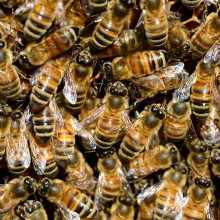
09:53 - What is the most intelligent insect?
What is the most intelligent insect?
University of York animal behaviourist Eleanor Drinkwater got stuck in to this question from Mariana...
Eleanor - I have been asked this before and this is always a really hard question because I am incredibly biased, and I believe that all insects are incredibly intelligent in all sorts of different ways, and that we haven't even begun to scratch the surface of what insects can do. So we probably, it could be the case that we haven't even discovered the cleverest insect. But if I was to choose one based on research about an individual who is pretty clever, it might have to be the bees I'm afraid, and there's some really cool research that has shown that bees can tell apart, the difference between different painting styles. So if you show them a Monet and a Picasso, you can get them to learn the differences and then be able to generalise to other paintings
Chris - And which do they prefer out of interest?
Eleanor - I don’t know! Maybe there'll be a follow up paper. I hope there would. But also they can tell the difference between people's faces and they can remember a face for two days which is incredible.
Chris - There was also a study that the researchers at Queen Mary University of London published a couple of years ago, where they showed a bee another bee rolling a ball into a goal, and the bee that was watching then learned how to get the bee ball into the into the bee goal and get a treat. So social learning.
Eleanor - And more than that, they did a follow on from that, which was even more cool; so they trained it on on one particular ball, and they had other balls in the area which they'd glued down while they were learning, but then in the second round they unglued the balls and the bee would learn the concepts, and then would apply it to closer balls, so then they would perform the same action, but on a set. So they weren't just learning “oh this ball goes in the hole”, they could like generalise, which is incredible if you think about it.
Chris - Anyone else got a favourite insect, in the studio.
Eleanor - Everyone should.
Bobby - I have the cicada.
Chris - Oh I know why you're gonna go with that, because they come out on prime number years don't they? Every 13 or 17 years cicadas emerge don't they?
Bobby - They do.
Chris - To minimise the chances of their mating year coinciding with predators.
Eleanor - It’s so cool!
Bobby - Exactly. I always tell my students that on a Friday afternoon these cicadas are probably smarter than my students on Friday at two o'clock.
Chris - Maybe even smarter than the lecturer, you never know. There’s a provocative thought. Dan, a favourite insect?
Dan - I don’t know, I suppose possibly the butterfly. Just purely because I just love the whole process from chrysalis to butterfly, but actually just the sheer variety of butterflies. I think it's just mind boggling.
Chris - They also do amazing feats of navigation the butterflies, the monarch butterflies for example, all the way from Canada down to New Mexico, and that kind of environs. It’s thousands of miles these tiny insects make, and they actually navigate, and they use their body clock and the position of the sun to navigate. And you think, this tiny insect, and you know I can't even find my way around London and these things find their way. They’re just an insect. I do find this quite amazing.
Eleanor - Yeah. You shouldn’t say just an insect, you mean an insect!
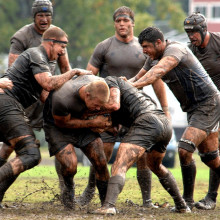
12:52 - Who is fitter: rugby players or footballers?
Who is fitter: rugby players or footballers?
Dan Gordon, exercise physiologist from Anglia Ruskin University, answers Ben's tricky question...
Dan - This is, I mean this is one of those, it’s a bit like the insect question, this is a classic question and it's actually, without wanting to sit on the fence, it's actually really difficult to say because you have to think what we mean by fitness. So actually a footballer is fit to play football, a rugby player is fit to play rugby, so I could sit on the fence and go: “Well actually, we don't really know.” Well, we know a little bit more.
I mean if we look at say, basic cardiovascular, cardiorespiratory fitness, what's interesting is that they're pretty similar. So if we take what's called the VO2 max, the maximum amount of oxygen that somebody can consume, the general population has a score of about 40 to 45 milliliters per kilogram per minute of oxygen. A male footballer is in the region of about 55 - 58 and a male rugby player is very very similar region.
Where it gets quite fascinating is when you look at things like distances covered, so the distances covered in a game of football, the midfielder’s running about 11 to 14 kilometres. Referees are actually running more, which is just a side issue. In rugby, actually again it's positional dependent. So if you're playing as a forward then clearly you're not going to run as much as for example a midfielder. But when you get into things like measures of strength, now we start to see the difference. Clearly rugby players are able to exert more force per unit of mass.
Are they more powerful? Again it depends on the position that you're playing. So it is a slightly loaded question. So if you know, if you're going to compare them on your classic TV show, and I don’t know if you remember Superstars. I mean I used to love Superstars, and you compared them, actually it was interesting that rugby players never used to do as well on Superstars compared to footballers, and the aim of that program was that you always compared people across different sports that took them out of their own events, and so going back to that era when we had superstars, then one might argue tentatively that footballer is fitter than a rugby player!
Chris - It is kind of a question of sort of horses for courses isn't it?
Dan - Absolutely.
Chris - Because if you took a rugby player, they're not going to be very good at the pole vault, are they? Let's be honest. But then, the vaulter is not going to be very good at rugby.
Dan - Exactly that. You know, I mean I always say to my students who's fitter at a sumo wrestler or a marathon runner. Of course they go marathon runner. But no, they're just not. They’re fit for running a marathon but they are not fit to be a sumo wrestler and actually you start getting down to genetics. So actually there is no way you're ever going to take a footballer and turn a footballer into a prop forward. That's just not gonna happen. You know, they don't have the genetics for building muscle mass. They don't have the genetics for force generation, and the flip side is the same for football. In football, there's a lot of this work to do with what we call stretch shortening cycle, which is this idea of a fast force production. Rugby players don't have that kind of fast force production as a football player. So there, you have got that large genetic component as well.
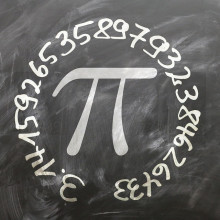
Does pi really go on forever?
Dee put this question to mathematician Bobby Seagull...
Bobby - Yeah so people have historically tried to come up with an answer, what is pi? So think, Archimedes used geometry, drew I think a 96 sided shape inside a circle, and outside, and try to come up with an approximation. And then in the seventeen hundreds a mathematician called Lambert proved it's irrational, so you can't write pi as a ratio of two whole numbers. And then in the 1880s, a mathematician proved it’s transcendental, showing that actually, you can’t determine its exact values, so actually it does go on forever and never repeats, and one of the cool things about pi is technically, all of our birthdays are there, all our date of death, all our date of engagement, our favourite number, our recipes, sort of our favourite mathematical recipes for cakes, everything is inside pi because it goes on forever.
Chris - So if you give enough monkeys enough calculators, eventually they'll reproduce pi.
Bobby - Exactly.
Fran - The monkeys would always be reproducing a part of pi right? Whatever they type, very intelligent really!
Eleanor - If one of your students writes down the wrong number for pi then I guess they could claim that they got it right!
Bobby - They could! I hope none of my students are listening to this!
Chris - But more seriously for a second Bobby, what actually is pi used for and how is it derived? How did they actually get to this magic number, which is incredibly powerful.
Bobby - So pi essentially, is the ratio between the circumference and diameter of a circle. So no matter how small or big a circle, that is approximately again roughly three times, a bit larger than three times, and in school we've seen people use approximation 22 over 7, that's 3.142857 recurring or three point one four. But again that ratio, it never ends, and we use it for I guess in physics, in areas of your life, but it's something which I think mathematicians currently, there's one mathematician, a computer scientist in Japan that I think earlier in 2019, used 25 computers over 121 days and came with 31 trillion digits to pi...
Chris - And is this really useful, because don't NASA just for the purposes of their calculations, stop at something like five or seven decimal places that they're satisfied that that's good enough.
Bobby - Yes and I think I've read somewhere that with 32 digits of pi you can then estimate the size of the universe to like, one protons width.
Chris Is that right Fran? Just to put you on the spot.
Fran - It sounds plausible.
Bobby - So we don't need that 31 trillion digits I'm sorry for the person who set that world record.
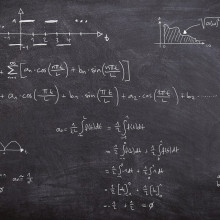
20:59 - The Life-Changing Magic of Numbers
The Life-Changing Magic of Numbers
Bobby Seagull, Cambridge University
Chris Smith interviews Cambridge University mathematician Bobby Seagull about his book, The Life-Changing Magic of Numbers...
Chris - Bobby, you’ve got a book sitting there, is this it, is this the new tome that you just put out?
Bobby - The life changing magic of numbers.
Chris - When's it out? Just now?
Bobby - So it is just come out this September. Yeah that's right.
Chris - Brilliant. And what's it about?
Bobby - It's partly autobiographical, but it's partly an ode to numbers because I know that as a maths teacher, if I go into a dinner party or meet friends at a pub and say that I love maths, I’m a maths teacher, pretty much the first reaction from most people, not all people and not the esteemed audience here or our listeners, our dear listeners, they'll be like oh God, maths, I hated it, I couldn't do it at school, what's the point of it. And my book is almost like a soft manifesto showing that actually maths is quite cool, quite fun, and appears in unexpected places.
Chris - All right, you've got one minute to convince us that maths is quite cool, quite fun and appears in unexpected places. Take it away.
Bobby - An unexpected place is in dating. I am currently single, and I am trying to use maths to help me to be unsingle.
Chris - That’s not a good opening line is it?
Bobby - No, it’s not! It’s not because of maths, it’s separate, it’s not causation! So firstly, I used an adapted version of Drake’s hypothesis to estimate the number of alien civilizations in our galaxy and …
Chris - If you want to date an alien, you're getting really desperate now Bobby.
Bobby - So again, initially I have used the hypothesis from Drake and according to my own version there are there 73 people I could date in the UK. That doesn't sound good.
Chris - But hang on a minute. So there’s 65 million people in the UK and there are just 75 that suit your parameters. I mean, how stringent are you being?
Bobby - Yeah, I think it's perhaps … the key thing is that I'm someone who likes Verdi, but Stormzy, but Bake Off, but Love Island. So I've got my own issues, but that’s separate. So the interesting part is that I use something called Optimal Stopping Theory to work out how many dates I need to go on.
Chris - And how many is it? Is it within a lifetime? Is this doable?
Bobby - So imagine I say I want to get married in five years, and I'm prepared to go on two dates a week for 50 weeks, that's 100 dates and over five years that’s 500. So actually Optimal Stopping Theory… you know “e” from the exponential? So 1/e gives us roughly 37%. And Optimal Stopping Theory says I need to go on 37% of my total 500 dates. That's a 185 dates, and I can't accept any of them, I have to reject all of them no matter if they love Bake Off and Love Island and University Challenge and then the person after the 185th date that is better than all of the previous ones, she’s the one. Obviously she has to accept as well.
Chris - That sounds like a fallacy though because there's an equal chance that the first date you go on will be your dream lifetime partner, surely, compared with the person who's the one after the 37.5% person.
Bobby - But again we don't know that the person could turn up as the first or the second or the third or...
Chris - But this is what I'm saying, so how do you know.. why are you saying you want to go with the one straight after…
Bobby - This might go better by putting it to pen and paper, but 1/e, 1/2.72 turns out to be, in any sort of decision, say you wanna buy a house and you got a hundred houses to go and look at, or you wanna buy a pair of shoes, it tells you that roughly about a third of the way through you need to discard the first third or 37% and then after, that mathematically you should get the best solution.
Chris - And how far through your hundred eighty five dates are you?
Bobby - About nine.
Chris - You've got a long way to go.
Bobby - I do!
Chris - Okay so you've convinced me that you can overthink things. What's the next fun and fantastic fact that we can learn about in the book?
Bobby - It comes back to cicadas. Because again, my students, we were learning about prime numbers recently and they often say “Oh sir, but Mr. Seagull, prime numbers you only use them in exam, I never see them anywhere in nature”. And then when you brought up, when you mentioned what's the most intelligent insect, and I loved telling my students about the cicadas. And these are little tiny creatures are apparently very tasty. It's only because I've seen them in a documentary and Marcus du Sautoy says they are tasty so I take his word. But again, the fact that they've evolutionarily developed the fact that emerging in 7,13 or 17 year cycles evades predators, I think that's amazing, because, had they picked 12 let's say, then any predator that emerges every 2, 3, 4 or 6 years will eventually overlap with it, and that for me is amazing. It shows actually, mathematics is something that not just humans practice but insects.
Chris - Sounds like a slightly dodgy argument though Bobby because the thing is, nature is very good at finding an opportunity, and maybe you can prop me up on this one Eleanor, but the fact is, if the cicadas have evolved to do that, then surely things that like lunching on cicadas would have evolved convergently to do the same thing wouldn't they? Why haven't they?
Eleanor - It's a really good question and one to which I would love to know the answer, but I don't know of any predators who follow this pattern. I guess in this particular case, you'd have to have a predator who was specialised in eating cicadas. So I'm guessing that they are banking on the fact that you get a lot of generalist predators who wouldn't bother to adapt specifically to eat them. But you never know, they might catch up one day.
Bobby - I think you sort of nailed it on the head there because an entomologist called Stephen Jay Gould said that potential predators often have shorter life cycles of 2 to 5 years so they can't really stretch and keep up with the ones who are greedy enough to save for a 13 or 17 years.
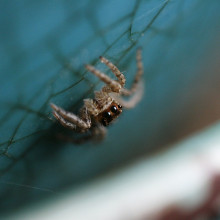
26:12 - Who are the better climbers, geckos or spiders?
Who are the better climbers, geckos or spiders?
Eleanor Drinkwater from the Univerisity of York answers this question from Jay...
Eleanor - I absolutely loved researching this question thank you very very much for sending in. And again I spent a lot of time looking up. And I'm absolutely thrilled to say that it's spiders that are better climbers than geckos. Fascinatingly, they use a very similar mechanism to stick to stuff and it's due to tiny tiny tiny hairs in their fingers.
Chris - Spiders have fingers now?
Eleanor - Yeah. Feet. pads, toes, legs, you know! But tiny tiny tiny hairs which interact with the surfaces that they stick to in a molecular manner, so they’re actually held on by Van der Waals forces. And so if like me you've spent quite a lot of time looking up the difference, you can find out how sticky these animals are to the different surfaces, and then divide them by the bodyweight of the animal. If you compare a jumping spider to a tokay gecko, you will find actually the jumping spider is three times more sticky than the gecko.
Chris - And just to be clear, the way they stick on is that their feet/fingers have tiny hairs and those hairs get very close to the thing they're trying to climb onto. And the electrical attractions between those tiny hair surfaces and the thing they're trying to climb on gives them enormous sticking power.
Eleanor - Yes, it's absolutely incredible.
Chris - So why don't they stick to their own web then?
Eleanor - I don't know.
Chris - One theory I did it hear is that those hairs are very spiky and so the droplets on the web - the sticky bits, if you look at a web it's got regular blobs of sticky stuff - and the spider a) knows where they are so it puts its feet somewhere else and b) the hairs are quite sharp and so the blobs tend to go towards the end like falling off a needle. And so they easily detach whereas other insects that are the prey get stuck in them because they have big juicy hairs that are less easy to disengage so they just get stuck and other bits of the insect body get stuck as well. So the spiders are canny: they know how to use their feet as well as where to put their feet and to have hairy feet that are hairy with sharp hairs, so the spider can detach easily!
Eleanor - However, that stickiness thing comes with a caveat! It depends on the gecko and depends on the spider. You get some geckos and some spiders that are more or less sticky than others!

28:33 - What's inside a quark?
What's inside a quark?
Physicist Fran Day from the University of Cambridge unpicks this question from Susan...
Fran - Okay. So a lot going on in this question. It's a very good question that's been puzzling physicists. Firstly just a few pedantic points. Electrons aren't made of quarks, only protons and neutrons are made of quarks. And when we say elements are made of atoms, we're talking about chemical elements. So things like oxygen, hydrogen, potassium not subatomic particles like quarks. Quarks that of course not made of atoms. As you point out that would be kind of circular.
So electrons and quarks are what we call fundamental particles. And this means that so far however much energy we've thrown at them, we've collided them with each other with as much energy as we can in particle colliders, and they've never broken into smaller parts. There's never been any evidence that they're made up of anything at all.
Now it might be that if we just put in more energy they will break apart and then we'll find out what they're made of. Or it might be that they're truly fundamental. that they're not made of anything. One thing that helps to understand how this can be, how there can be something that isn't made of anything, is to think about quantum field theory. Which is really the most fundamental theory we have about how the universe works. Quantum field theory asks the question “what is an electron really?” And the answer to that question is that an electron is a kind of ripple in the electron field. This entity that covers all of space and time. It’s the same for every other particle. We think that what we call particles are ripples or waves in fields that have spanned the universe since the Big Bang. It's like ripples on a pond. And these fields are really the fundamental objects of the universe, not the particles. And anything more than that “what are the fields made of?”, well that we don't know.
Chris - So when we pick up an oxygen atom there's stuff in there which you're saying happens to be in that space is a bunch of ripples that are in that particular point in space and time, ripples in the fabric of space?
Fran - Yes.
Chris - So when I move that atom I'm moving those ripples around so that those ripples are a distortion but they can move?
Fran - Yeah. So one thing to clarify is that these quantum fields, a field allocates a number to every point in space, so like the electric field would have a value everywhere. It's not the fabric of space time in the sense that we talk about when we talk about gravity. So these are fields that cover space but when there's a ripple, we don't see it gravitationally in the same way that say a black hole causes space to bend.
Chris - So could these things be sitting in some other bizarre dimension that we see it in the dimensions that we're familiar with interacting with, but there are other dimensions that we can't see, they're hidden from us let's say. And that's where actually the thing that gives the quark its existence is sitting. And actually the vibrations or the repercussions of that are manifested as these ripples that we see as a part of an oxygen atom here on Earth right now. But actually it's some other entity in some other dimension that we just don’t know it's there.
Fran - There are theories that postulate extra dimensions, in particular to explain why gravity is so weak because it's acting over more dimensions. But we just don't know. When these quantum particles that are described as ripples interact with each other, you can think of it a bit as when you have ripples travelling along in water. They can interact with each other. And when I pick up an atom and move it, remember that my hand is also basically a ripple. So that's just the ripple that is my hand interacting with the ripple that is the oxygen atom.
Chris - So is just ploughing more and more energy into more and more exotic, energetic collisions just not really the best way to go with this, because it may just be we're not actually going to discover - because that's not the way to unlock - what lies downstream of these particles?
Fran - It's possible and we are trying lots of different approaches. So my research in particular is using astrophysical observations to look at really all kinds of different extreme environments to try and learn more about particle physics. But I do think there is an awful lot of value in just building a bigger particle collider. Smashing stuff together with increasing energy has worked for scientists for many centuries and I don't see a reason to stop now.

What's the diameter of a neutron star?
Eleanor Drinkwater, York University; Bobby Seagull and Fran Day, Cambridge University; Dan Gordon, ARU
We test the metal of our panelists with some questions of our own! Chris Smith puts them to University of York animal behaviour scientist Eleanor Drinkwater, exercise physiologist Dan Gordon from Anglia Ruskin University, Cambridge University physicist Fran Day, and Cambridge University mathematician and University Challenge icon Bobby Seagull...
Chris - Team 1 are gonna be Fran and Dan, and Team 2 are gonna be Bobby and Eleanor. And Round 1 is called Around The World. So please confer you two, Fran and Dan, Team 1. Which of the following megacities, referred to as cities of more than 10 million people, has the biggest population. Karachi, Moscow, or Istanbul?
Fran - I just don't know. Do you know?
Dan - Well. I would take a guess at Karachi.
Fran - Yeah that sounds plausible. I’ll just go with that.
Chris - You’re going Karachi?
Fran - Yes.
Chris - Yep. That is correct. Karachi’s got 18… Bobby sounds so surprised.
Bobby - I was sort of expecting Istanbul.
Chris - Ah, no. Karachi's got 18 million people. Istanbul's snapping at its heels though, 14.5 million. And Moscow - just over 13. London though, way down the list, nearer 9 million. Team 2, Eleanor and Bobby. According to the Guinness Book of World Records, which is the biggest - you have to listen to these carefully: the smallest country in the world, the smallest republic in the world, or the smallest colony in the world?
Bobby - So smallest country, smallest republic, smallest colony. Smallest country is the Vatican, it’s about 0.44 square kilometres. So the smallest republic and the smallest…
Eleanor - I’d say the smallest colony would probably be a colony of ants, probably. But.... if that's not the answer I’m going to be very disappointed.
Bobby - So which is the largest of the three. Smallest republic - what is a republic? I’m getting into quite political terms here. Are we a republic yet? No we're not. Oof, I don’t know.
Chris - Gonna have to hurry you.
Eleanor - I'm going to go for colony, because if it is the animal route - which I'm obviously predisposed to think it is - then you can talk about supercolonies, and they can stretch across huge distances.
Bobby - Let's go for that.
Chris - Do you know, I would be tempted to give you a bonus for really clever thinking, OK. It's not actually right. I'm going to have to give you a...
Eleanor - Oh, I’m sorry, I’m sorry!
Chris - But I thought it was ingenious thinking so I’ll give you half a point for that, because... and actually some of those mega-colonies of ants though, Eleanor, are huge though, aren’t they. Which makes them bigger than, in fact, probably Vatican City which is tiny. That's just 0.44 square kilometres. And I'm pretty sure there are ant mega-colonies which span a bigger area than that.
Eleanor - Definitely.
Chris - But the answer to the quiz question is: the smallest republic is Nauru, which is in the Pacific Ocean, 21 square kilometres. Smallest colony? Anyone? Any ideas? Gibraltar. It's 5.8 square kilometres on that one. Okay so we've got, you're just about in the lead Fran and Dan with half a point in it. Next round, Round 2. Tech Yes or Tech No? Which of the following is a ‘tech no’ - in other words which one did we make up? OK, of these three: a bed that tucks you in at night; a frying pan that counts calories in your dinner; or a games console for your pet pooch. Which one is a ‘tech no’?
Dan - Ah, man. They all sound like they could be there, don’t they!
Fran - Yeah. I think that dog games console - if that doesn't exist then I'm gonna make it.
Dan - That’s got to be. Yeah.
Fran - A bed that tucks you in…
Dan - I’ve seen the bed that tucks you in.
Fran - Oh really?
Dan - I'm pretty sure I’ve seen that…
Fran - Isn’t it kind of dangerous and creepy?
Dan - I'm pretty sure I've seen something on Facebook that does this, Facebook shows everything…
Fran - So there’s these gravity blankets that are just really heavy?
Dan - Yeah, I'm sure I've seen something which is designed for people who are disabled that in essence... I don't know how it works. I seem to remember seeing something that, the sheets are able, the blankets are able to pull themselves across.
Fran - So how would the frying pan thing work though? Because the way I know to see how many calories are in something is to burn it. Then you wouldn't have any dinner, so that’s not ideal.
Dan - So have we talked ourselves into it? Shall we go with the frying pan?
Fran - Yeah, let’s go with the frying pan.
Chris - You’re going ‘tech no’ is the frying pan?
Fran - Yeah.
Dan - Oh, no.
Chris - No actually it is the bed. The bed is the ‘tech no’. The frying pan comes with its own app and a built-in scale so it can weigh and then quantify how many calories you're allegedly going to get. The games console, the idea of that is that your dog does a little puzzle and it gets a treat in return for its labours. So unfortunately no points for that one. So currently the scores stand at one point to Dan and Fran, half a point to Eleanor and Bobby. Your chance to take the lead here, Eleanor and Bobby. Same question, which of the following is a ‘tech no’: a mask for your mouth to stop you annoying everyone around you having loud phone conversations; a phone soap; or smart hair bobbles, they tell you when they're about to snap before your hairdo collapses.
Bobby - A mask for your mouth?
Eleanor - But also the hair bobbles thing - if you're wearing it in your hair, then if it's about to snap, you wouldn't be able to tell because it would be in your hair.
Bobby - So it sounds ludicrous, you think.
Eleanor - Yeah. You know, as someone who wears hair bobbles, this sounds not very useful. But then again just because it's not very useful doesn't mean that it doesn't exist.
Chris - What are you going to go for then?
Bobby - Is it the hair bobbles?
Eleanor - Yeah, but then again the mask for your mouth sounds bizarre as well.
Bobby - I want to invent that, that sounds... shall we go for the hair bobbles?
Eleanor - OK, we can go for the hair bobbles.
Chris - You’re gonna go hair bobbles? Gonna go hair bobbles… it is… correct! So one and a half points to Eleanor and Bobby so far, so they’re half a point ahead. It could all be on this one. Here we go, OK, Round 3. This is potentially the decider. This round is called On The Other Foot. This is where we ask the team something about something that the other team probably know quite a bit about, and so you have to keep very quiet, other team; and then you can gloat when they do or don't get it right. So Fran and Dan, according to Wikipedia which of these is the smallest mammal: the bumblebee bat, which is a vulnerable bat species with a reddish-brown or gray coat and piglike snout; the Etruscan shrew, which looks a bit like a mouse but has an elongated nose and eats mainly insects; or the long-tailed planigale, which is a small marsupial, also looks a bit like a mouse, has a flattened head and it can get through very narrow cracks. What do you think?
Dan - They all sound small. All of the above.
Fran - Well the last one must be quite small to get through very narrow cracks, in the description.
Dan - But you said that the shrew was apparently mouse-sized as well.
Fran - Oh. Yeah. Maybe it's the bat, maybe it’s... because it’s called the bumblebee bat, and bumblebees are smaller than mice.
Dan - Shall we just do it?
Dan - OK, we think it’s the bat.
Chris - You’re going to go with the bat?
Fran - Yep. Oh, yay!
Dan - High five!
Chris - Yes. Well Eleanor and Bobby: what's the diameter of a neutron star? Is it 20 kilometres, 20,000 kilometres, or 20 million kilometres across?
Bobby - Neutron star, presumably it’s quite small.
Eleanor - I have no clue.
Bobby- So 20, 20,000 or what was the last one, 20 million?
Eleanor - Yeah.
Bobby - 20 kilometres sounds too... that sounds more black holey. How about 20,000?
Eleanor - I… yes. I agree.
Bobby - The middle option!
Chris - Going for 20,000?
Eleanor - No!
Chris - Did you know that Fran?
Fran - Yeah, it's 20 kilometres.
Chris - It is 20 kilometres, yeah.
Bobby - It really is that! Oh my god, I thought it was...
Chris - Neutron stars are actually very small, they’re actually roughly the size of a city in terms of diameter, and a teaspoonful full of one would weigh about 10 million tons. Our own sun in comparison: 1.4 million kilometres in diameter. So there you go, our big brain winners of the week are Dan and Fran. Give yourselves a big round of applause, very well done.
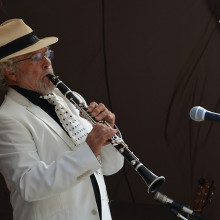
42:20 - Do wind players have specialised lungs?
Do wind players have specialised lungs?
Chris Smith put Bruce's question to Anglia Ruskin University's Dan Gordon...
Dan - This is actually a really interesting question. The answer is no. I think it's quite surprising. So there's been a number of studies that have been done, where they've compared using different methods. The classic method is just using measures of respiratory function. So looking at total lung capacities, measuring things like fractional extraction - so you measure the amount of air that's extracted in one second for example - looking at residual volumes - you’ll have a residual volume. If you don't have residual volume, the lung collapses.
So they've measured all of these and actually what they found is when you compare one instrument player to a non instrument player there is no difference in any of these measures at all. What is different of course is the way in which the lungs are used. There are differences for example in the strength of the diaphragm. There are differences in the way in which the lung is filled, but the thing I found really fascinating about this, which actually when I sat down and thought about it I though actually makes an awful lot of sense, is the wind instrument players actually have a lot of inflammation in the lung. A lot of lung damage.
And actually put into the context of athletes, if you are doing vast amounts of repeat work where you're stressing something to its maximum you cause inflammatory responses. And so what they’re finding in wind instrument players is actually if you measure their lung function on a scale, it looks worse than the general population, because they've just caused these inflammatory responses.

44:15 - What is the cosmic microwave background?
What is the cosmic microwave background?
Cambridge University physicist Fran Day tackled this cosmic question from Martin, who got in touch via Facebook...
Fran - I think what's being referred to here is the cosmic microwave background. This is radiation that was produced 400,000 years after the Big Bang, but in cosmic timescales that's nothing. And it was produced at a time in the universe when electrons and protons were combining to make neutral hydrogen, and that produces all of these photons. And this happened everywhere in the universe at once. So it didn't just happen at a point. It happened across the universe.
Now since that time, four hundred thousand years after the Big Bang, the universe has been expanding. So this radiation, these photons, have just been travelling through the universe as it expanded, and the effect that that has is to stretch them. So the effect of the expansion of the universe is that we see the radiation, the light, from the cosmic microwave background as having a longer wavelength. But because the universe is expanding, everything just expands in that together. So the radiation is everywhere in the universe. And the stuff that we see is the stuff that just happens to be where you are. But it is just travelling through this ever expanding universe.
Chris - One argument I heard for this that put it I thought quite well, is that for something to be sending us radiation like this from all directions, argues that the stuff which is across the universe must have at some time all been together in one place and shared the energy of the Big Bang equally amongst all those particles, so that when the universe then inflated very very fast - which it did far faster than light in everything else in the very early phases of the universe - it took all those bits with it that had shared all that energy. And now they are busy radiating that energy in all directions at us. And as you say because the universe is also inflated it stretched the light out. So we see this stuff at very long wavelengths. But it is coming at us from all directions because the material that it was all part of in the very early universe is now everywhere, and so it's now sending us radiation whichever way we look.
Fran - Yes that's exactly right and that's really why the cosmic microwave background is very uniform in all directions. Which is quite surprising because it's spread across the whole universe, and this is one of the reasons we think we need this period of inflation where the universe expanded very very quickly at the start of the universe, so that it can all have been together at one stage.
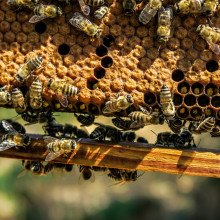
48:29 - How do bees make wax?
How do bees make wax?
Animal behaviourist Eleanor Drinkwater got stuck into this question from our forum...
Eleanor - It's pretty adorable. So it also comes from the bees, so it's the youngest bees in the hive. Essentially what they do is they huddle together, they raise their body temperatures and then they start producing little tiny drops of wax from glands under their abdomen, and then the older workers can come and kind of harvest this wax from the younger workers, but it's incredibly costly to make. For about one gram of of wax, it takes about six grams of honey to produce, so it's very very valuable within the hive.
Chris - And so the bees have glands in their bodies that turn the energy in honey into wax, because wax is a hydrocarbon, you can burn it can't you? It's like oil. So how are they turning honey which is sugar into oil
Eleanor - With difficulty. And the interesting thing too is about the fact that they lose this ability as they get older. So it's only within these glands that they can do this, and it's only within a certain period of this animal's lifecycle which is really cool.
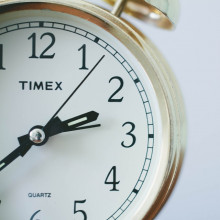
49:38 - What's the record for someone holding breath?
What's the record for someone holding breath?
Exercise expert Dan Gordon took on this question from Phil...
Dan - We've got to be slightly careful, because there's a lot of information out there which is slightly misleading. So the current world record for holding breath is eleven minutes thirty-three seconds.
Chris - Oh my goodness.
Dan - Now you will see that there are also reports out there of somebody being able to hold it for twenty four minutes and three seconds, so the caveat on that one is they were allowed to breathe 100 percent pure oxygen before. So what they did was they breathed 100 percent pure oxygen and it's still extraordinary. And then held their breath for twenty four minutes and three seconds. But if we go with what's recognised in breath holding circles, and it's actually part of the free diving community, so if you look at the free diving challenges, it's not just about how deep somebody can dive.
It's actually, the second challenge is having somebody lying just you know, in a swimming pool and holding their breath. And it was a couple years ago, 2016, it was eleven minutes thirty-three. Actually, there’s a couple of real simple parts to this. We all have what's called mammalian dive reflex, and it's designed to prevent us from dying very very quickly in water. If you hold your breath, your heart rate slows down, and part of that is you start to get a vasoconstriction in the periphery. So what happens is that oxygenated blood rather than going into the limbs, is actually going primarily to the brain, still a lot going to the heart. But the majority is going to to the brain and we see this in any mammal.
Chris - Can I just clarify there Dan? So by pushing all the blood towards the central organs, heart, and brain, you're basically stopping the rest of the body having dibs into the oxygen that's in there. So those crucial organs, heart and brain, which are most oxygen deprivation sensitive they've got longer to have dibs at the oxygen you have got. Is that why this works?
Dan - So what's happening is, if you imagine you've got X amount of oxygen and you reduce the amount of oxygen going to the periphery, then that oxygen can be used. And the key variable here is the brain. What you don't want to be using is that oxygen in the limbs and so on and so forth. He's just burning up, in inverted commas, energy. The second part, and this is why all these records are broken in water, is we have what are called the trigeminal nerves, which are in the face and that actually if you put somebody's face into cold water, the trigeminal nerves are actually acted upon and they actually cause an inhibitory effect, again on heart rate.
So through the autonomic nervous system the heart rate then slows down. So you get not only the mammalian dive reflex but you get this secondary effect. And so when they go for these breath holding records, they always do them in fairly cold water.
Can we train for this? So I'm going to put a caveat here, which is please please please do NOT try this at home okay. Because what we don't want to hear is people passing out and fainting and so on and so forth. The first thing to recognise is that these individuals have incredibly large lungs. A typical lung capacity is four to six litres, most breath hold divers have a lung capacity in excess of 10 litres.
Chris - Do they always have that Dan, or have they got better?
Dan - You can't increase lung capacity. So this is one of the interesting things when you look at athletes, athletes can increase everything, you know heart size can increase, and muscle mass increase. Lung capacity cannot increase, you get what you're given. And so these guys have got this natural genetic endowments of about a 10 litre lung capacity which is fundamentally important. They've actually got increased haemoglobin concentration. They've got greater red blood cell counts. So what they've got is a greater oxygen transport system and oxygen utilisation system.
Chris - And a better reserve in the blood in the first place, they’ve got more places to store it for longer.
Dan - Correct. Correct. So there's a lot of work that's been done out in places like the Karolinska Institute, and what they found is that the key is relaxation. If you imagine that the brain is where the majority of this oxygenated blood is going to, the last thing you want to be doing is thinking about what you’re having for dinner, because as soon as you do that the brain is active. The brain is then going to use that very very limited store of oxygen. So there was some work that was done actually in the UK, a number of years ago, where they measured EEG patterns in breath hold divers and what they were looking at was when they got them to do just a breath hold. They were looking at the EEG patterns.
Chris - This is the brain wave activity?
Dan - This is the brain wave activity. And what they found is in the best breath hold divers, was that the brainwave activity just, it was almost like watching somebody shut the computer down. These signals just started to decrease, and the guys that were new to breath hold diving, actually had very active brains. So the first thing is relaxation. They talk about doing what's called progressive muscle relaxation, which is a technique that’s used to prevent things like anxiety, which is the idea that you go through tensing the feet first and relaxing the feet, then the calves, then the quadriceps, and you do this across the whole body to put yourself in a state of relaxation.
The second thing that you have to do, is what the best athletes do, it’s what's called lung packing. Whereby you basically over pack the lung with air. Most of us really don't actually use our lungs to their full capacity and lung packing is a technique whereby you use the glottis to, in essence, get more air into the lungs and inflate the lungs, inflate the lungs, inflate the lungs. There is a downside to this, which is why I'm saying please don't try this at home, which is that actually this starts to then cause decreases in carbon dioxide concentration. And so the net result is that people just start to pass out. What they showed in a number of studies is that you can take people who can hold their breath, typically most people can hold their breath for about a minute, minute and a half, and actually if you go through this progressive muscle relaxation and even do a very basic form of lung packing most people be able to get to four minutes, four and a half minutes.

55:50 - Can data help sport performance?
Can data help sport performance?
Mathematician Bobby Seagull and exercise expert Dan Gordon crunched the numbers of this question from Matt, who got in touch via Twitter...
Bobby - That's a good question, because in America a film came out a few years ago called Moneyball. And it showed how they used something called sabermetrics, where they looked at players that were undervalued compared to what the market rated them. So it transformed baseball, so actually every team in baseball started using this - to the point where actually it lost its competitive advantage. What we've seen in football is that there is a bit of resistance, because sometimes you see - like I play a lot of football - managers, coaches saying, “ah, it’s all about the gut feeling, you can tell if a player's good or not.” But there are also other teams like Brentford Football Club, they use a lot of data and metrics, they actually get data scientists in. And I think it's one where, for young players perhaps you can use it for, like, how many kilometres you’re running in a game, and the amount of passes. And it's definitely helpful, but I think football and sport… it’s still where there are other things like guts and honesty, integrity, someone wanting to, like David Beckham in 2001 running the extra yard because he really wanted something, where... I think it's hard to metricise sport like football.
Chris - There's a huge human factor. Is that what you were gonna say?
Dan - Well I was partly, but I was going to say actually a lot of sports really are buying into this. We know for example now rugby uses this kind of approach, it came from American football. I mean it is data, data driven. And now what they're using is GPS monitoring, so live GPS monitoring, and you have these guys who are performance analysts. It's not just about the physicality, they're starting to now get into trying to look at… and Bobby will know the terminology better than I do, but they’re starting to do this kind of analysis about movement patterns, so the way in which these individuals swarm. To the point now they've looked at this in Tour de France cyclists, so the Australian Institute of Sport have been looking at this. It's the same kind of research they've been doing on when you watch these swarms of birds. And they've been taking that same approach to say, “well actually the peloton in the Tour de France will swarm in this kind of way. And when it swarms in this kind of way we know these things start to happen.” So it's being used in multiple different ways in different sports.
And Bobby's point’s right, there are certain sports which I think are slightly reticent about using this, and still perhaps go with the older, the gut feeling approach. But this kind of performance analysis is really pretty much embedded, I mean dare I say, even teams like Cambridge United are using this approach; because actually it gives you enormous information. Very briefly I was out in Brazil recently, and I was at two of the big teams in Brazil. And they were showing me how they are using this performance analysis data to now be able to work out and say to the manager, “right, based upon this data that we're getting, this player is now at a risk of injury.” And so what they've been able to do is then take that data and then link that to metrics that they've got in terms of measures, actual measures of injury, and it ties up really nicely. So they can look at this on-field data and say, “right, based on this data you need to pull this player out of the game.” And Cruzeiro, which is one of the big clubs in Brazil, have been using this, and it's proved to be really quite successful.
Chris - Bobby?
Bobby - I think the sports where they're individuals, let’s say running or swimming, I think you can use data because then you can work on individual performance. But when there's multiple factors it becomes very complicated. I think football, even rugby, I think the more there are multiple variables, I think the more difficult it is to use computer science to help predict.
Eleanor - Do you think this is having any impact on the mental health of the players? I can imagine if you're being monitored like that, it would certainly make me feel uncomfortable.
Dan - I mean that’s a fascinating question, isn't it? And I think the mental health part is huge in sport, and I don't think we've ever really... we haven’t ever looked at that kind of association between these kind of metrics, but there is so much monitoring going on now with players, and they have a role…
Chris - But everyone says this, don't they. That they feel they're in a surveillance society. And it does have an impact. But maybe it might improve performance?
Dan - Well we're doing it because we think that it helps with performance. I mean, I know British Cycling been using this for years and years and years.
Related Content
- Previous Why am I addicted to eating toilet paper?
- Next Boffins on Mars









Comments
Add a comment